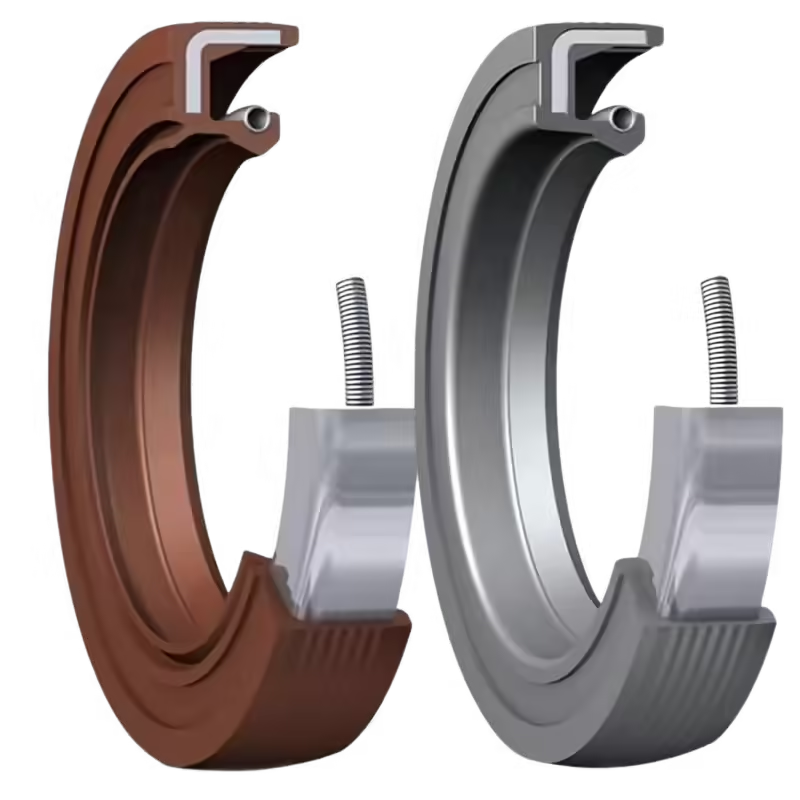How Should Toyota Choose an Oil Seal?
Introduction
In the realm of automotive engineering, oil seals play a pivotal role in maintaining vehicle performance, efficiency, and longevity. For a renowned manufacturer like Toyota, selecting the appropriate oil seal is crucial to ensure that each vehicle operates seamlessly under various conditions. The choice of oil seal material, design, and application directly impacts the effectiveness of sealing, thereby preventing leaks and contamination. This article delves into the critical factors Toyota must consider when choosing oil seals, emphasizing the importance of precision in material selection, design, and application to uphold Toyota’s standards of excellence.
1. Understanding the Key Factors in Oil Seal Selection
Sealing Function
The primary function of oil seals is to prevent the leakage of fluids and protect internal components from external contaminants. In Toyota vehicles, oil seals ensure that engine oil, transmission fluids, and other lubricants remain contained within their respective systems, safeguarding the engine and other critical parts from wear and damage.
Operating Environment
Oil seals must perform reliably under varying environmental conditions. Factors such as extreme temperatures, high pressure, humidity, and exposure to aggressive fluids significantly influence the choice of oil seal. Toyota operates in diverse markets, each with its unique environmental challenges, making it essential to select oil seals that can withstand these conditions without compromising performance.
Mechanical Load and Motion
Automotive applications involve both dynamic and static sealing requirements. Oil seals in moving parts, such as crankshafts and wheel hubs, must accommodate constant motion and varying loads. Understanding the mechanical stresses and movements specific to each application is vital for selecting oil seals that maintain their integrity and sealing capability over time.
Vehicle Performance Requirements
High-performance engines, braking systems, and other critical components place additional demands on oil seals. These seals must endure the stresses associated with high-speed operations, increased engine loads, and elevated temperatures, ensuring that the vehicle maintains optimal performance and reliability.
2. Material Selection Criteria for Oil Seals in Toyota Vehicles
Temperature Resistance
Oil seal materials must perform effectively under both high and low temperatures found in engine compartments and transmission systems. For instance, Fluorocarbon (FKM) is suitable for extreme temperatures, while Nitrile (NBR) is ideal for moderate temperature ranges. Selecting the right material ensures that the seal maintains its properties and functionality across temperature variations.
Chemical Resistance
Oil seals are exposed to various chemicals, including engine oils, lubricants, fuels, brake fluids, and transmission fluids. Materials like Fluorocarbon (FKM) and EPDM offer excellent chemical resistance, ensuring compatibility with these fluids and preventing degradation or failure of the seal.
Wear and Abrasion Resistance
High-performance engines and transmission systems generate significant friction, necessitating oil seals with superior wear and abrasion resistance. Materials such as Polyurethane (PU) and advanced elastomers are capable of handling heavy wear conditions, extending the lifespan of the seals and maintaining effective sealing over prolonged use.
Compatibility with Fluids
Ensuring that oil seal materials are compatible with the specific fluids used in Toyota’s engines, transmissions, and braking systems is crucial. This consideration extends to seals used in hybrid or electric vehicles, where different fluids may be present. Materials like EPDM or Silicone are preferred for their oil-resistant properties and compatibility with a wide range of fluids.
3. Performance Requirements for Oil Seals in Toyota’s Diverse Vehicle Models
Passenger Vehicles
Standard passenger vehicles require oil seals that can handle moderate temperature and pressure ranges. Materials such as Nitrile rubber or EPDM are typically used, providing reliable sealing for engines, transmission systems, and brake components without the need for specialized performance characteristics.
Performance and Sports Cars
Performance and sports cars demand higher durability from oil seals due to increased speeds, engine loads, and operating temperatures. High-performance materials like Fluorocarbon (FKM) or Polyurethane (PU) are employed to ensure that seals can withstand the rigorous demands of these vehicles, maintaining performance and reliability under extreme conditions.
Electric and Hybrid Vehicles
Electric and hybrid vehicles have unique sealing requirements for their electric drive systems and hybrid powertrains. Seals must exhibit low friction and high chemical resistance while being compatible with electrical components and cooling systems. Materials such as EPDM or Silicone are preferred to meet these specialized needs, ensuring efficient and reliable operation of electric and hybrid systems.
Heavy-Duty Trucks and Commercial Vehicles
Heavy-duty trucks and commercial vehicles operate under more severe conditions, including higher pressures and prolonged exposure to aggressive fluids. Oil seals for these applications require heavy-duty elastomers like Nitrile and Polyurethane, which offer the necessary resistance to pressure and chemical exposure, ensuring durability and reliability in demanding environments.
4. Design Considerations for Toyota Oil Seals
Shape and Configuration
The shape and configuration of an oil seal are fundamental to its sealing effectiveness. Toyota must choose between single-lip, double-lip, or multi-lip oil seals based on the specific application, such as engine crankshafts or wheel hubs. Each configuration offers different levels of sealing performance and suitability for various operational demands.
Spring-Loaded vs. Non-Spring-Loaded Seals
Deciding between spring-loaded and non-spring-loaded seals depends on the sealing requirements of the application. Spring-loaded designs provide enhanced sealing under pressure, making them ideal for high-pressure environments. Conversely, non-spring-loaded seals may suffice for lower-pressure conditions, offering simplicity and cost-effectiveness where high sealing force is not necessary.
Lip Design and Fit
Customizing the lip geometry of oil seals ensures a perfect seal with minimal friction. Selecting materials with the appropriate hardness is essential to prevent wear and damage while maintaining effective sealing. Precise lip design enhances the seal’s ability to conform to the mating surfaces, ensuring longevity and reliability.
Durability and Longevity
Oil seals must be designed to last throughout the vehicle’s lifespan, minimizing maintenance requirements and downtime. Durable materials and robust design features ensure that seals maintain their integrity and performance over extended periods, contributing to the overall reliability of Toyota vehicles.
5. Testing and Quality Control for Oil Seals
Simulating Real-World Conditions
Extensive testing under simulated real-world conditions is essential to ensure the reliability of oil seals. This includes exposure to extreme temperatures, high pressures, and harsh chemical environments. By replicating the operational stresses that seals will encounter, Toyota can verify their performance and durability before deployment.
OEM Standards
Adhering to Toyota’s stringent Original Equipment Manufacturer (OEM) standards ensures consistency and reliability in every oil seal produced. These standards encompass material quality, manufacturing processes, and performance criteria, guaranteeing that each seal meets Toyota’s high expectations for vehicle performance and longevity.
Failure Modes
Understanding potential failure modes such as wear, cracking, or deformation is critical in the testing phase. By identifying and addressing these issues during development, Toyota can prevent seal failures in the field, enhancing the overall reliability and safety of their vehicles.
6. Supplier Considerations for Toyota
Supplier Selection
Partnering with suppliers that possess the expertise and capability to produce high-quality oil seals is paramount. Suppliers must meet Toyota’s stringent requirements for material quality, manufacturing precision, and consistency, ensuring that each oil seal delivered aligns with Toyota’s standards.
Cost vs. Performance
Balancing the cost of raw materials and manufacturing with long-term performance benefits is essential, especially in high-volume production scenarios. Toyota must evaluate suppliers based on their ability to deliver cost-effective solutions without compromising on the performance and durability of the oil seals.
Sustainability
In alignment with Toyota’s sustainability goals, sourcing eco-friendly and sustainable materials for oil seals is increasingly important. Suppliers must demonstrate a commitment to environmentally responsible practices, contributing to Toyota’s broader efforts to reduce its ecological footprint.
7. The Role of Standardized Part Numbers in Toyota Oil Seal Selection
Unified Part Number System
Toyota employs a standardized numbering system for oil seals, using the prefix 90311. This unified part number system facilitates consistency and ease of identification across various models, streamlining the parts catalog and simplifying the selection process for both manufacturers and service providers.
DRO’s Capability
DRO Rubber offers a comprehensive range of Toyota oil seals for all models, leveraging the standardized part number system to provide a one-stop solution for oil seal needs. This capability ensures that Toyota can source the exact seals required for any vehicle in their lineup, maintaining consistency and reliability in their supply chain.
8. Related Search: How to Size Oil Seals?
Accurate sizing of oil seals is crucial to ensure effective sealing and compatibility with specific applications. For detailed guidance on measuring and sizing oil seals correctly, refer to the previously written article on drorubber.com, titled “How Do You Measure Oil Seals?” This resource provides comprehensive instructions to assist in selecting the appropriate size for various automotive applications.
Conclusion
Selecting the right oil seal is a multifaceted process that Toyota must approach with precision and expertise. Key factors such as material selection, design considerations, performance requirements, testing, and supplier quality all play integral roles in ensuring that oil seals perform reliably under diverse operational conditions. By prioritizing these elements, Toyota can maintain the reliability, efficiency, and longevity of its vehicles. DRO Rubber stands as a trusted partner in this endeavor, offering a full range of high-quality oil seals that meet Toyota’s stringent standards. For more information on high-quality oil seals, visit drorubber.com or contact us via WhatsApp at +0086 15815831911 or WeChat: +0086 13784044874.





